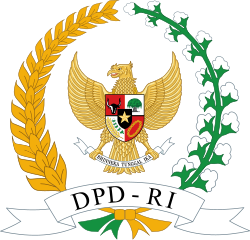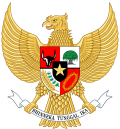History
The idea of regional representation in parliament was initially accommodated in the original version of the 1945 Constitution, with the concept of Utusan Daerah (Regional Representatives) in the MPR, along with Utusan Golongan (Group Representatives) and members of the DPR. This is regulated in Article 2 of the constitution, which states that "The MPR consists of members of the DPR plus representatives from regions and groups, according to the rules established by law". This loose arrangement was then further regulated by various laws and regulations.
In the Constitution of the United States of Indonesia enacted in 1949, the idea was realized in the form of Senat Republik Indonesia Serikat (Senate of the United States of Indonesia), representing the states and working side by side with the DPR.
As a replacement for Utusan Daerah, the DPD was created by the third amendment to the 1945 Constitution enacted on 9 November 2001 in a move towards bicameralism. The DPD does not have the revising powers of an upper house like the United States Senate. Article 22D restricts the DPD to dealing with bills on "regional autonomy, the relationship of central and local government, formation, expansion and merger of regions, management of natural resources and other economic resources, and Bills related to the financial balance between the centre and the regions."
The International Foundation for Electoral Systems conducted a tracking survey in the Indonesian legislative elections in 2004 which showed that not all voters knew how to vote for candidates for the new Regional Representative Council, or were even aware of its existence. [6] The first 128 elected senators of the DPD were sworn in for the first time on 1 October 2004.
The DPD is not a true upper house, because the power of the DPD is relatively weak compared to the older chamber, the DPR, notably, it has no direct law-making or the power to veto bills. [7] According to Indonesian constitutional scholar Jimly Asshiddiqie, the relative weakness of the DPD was a result of a compromise in the committee responsible for the constitutional amendment. The reformist faction wanted a strong second chamber in addition to the existing DPR to strengthen checks and balances, but the conservative faction opposed this.
Membership
Article 22C of the Constitution says that all members of the DPD are elected through the same legislative election every five years, along with the members of the House of Representatives. The total number of senators is limited so that it does not exceed one-third of that of DPR. Each of the 38 provinces of Indonesia elect 4 members to the DPD, for a total of 152. At the inaugural 2004 legislative election, there were 32 provinces resulting in 128 senators, but as new provinces have been created the number of senators has been increased in subsequent elections. The number of senators were 132 starting in 2009, 136 starting in 2014, and 152 starting in 2024.
Senators are elected on a non-partisan basis using single non-transferable voting. However, many candidates in the 2004 election had links to the parties represented in the House of Representatives, the Dewan Perwakilan Rakyat or DPR. The senators elected to the Council represent the interests of their provinces, therefore the DPD can be seen as a reform of the utusan daerah (regional representatives) of the MPR during the Suharto era, which was appointed to the MPR at the president's discretion. [7]
This page is based on this
Wikipedia article Text is available under the
CC BY-SA 4.0 license; additional terms may apply.
Images, videos and audio are available under their respective licenses.



